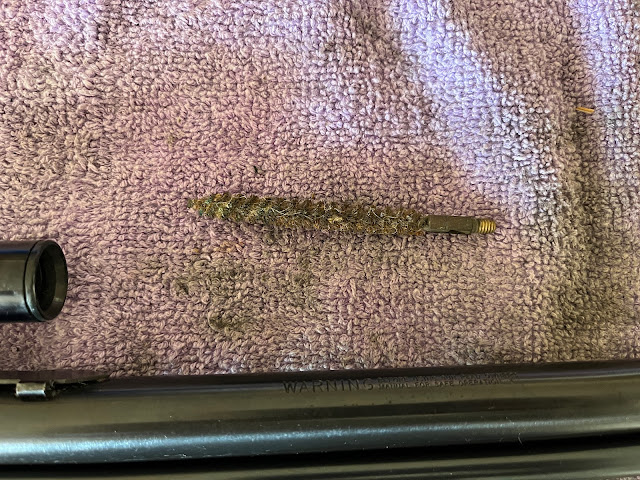I purchased another Marlin-Glenfield model 60 earlier this year. The gun was older than the other two I currently own and had a stock that had been repaired.
My first step is always to try and determine when the gun was made. Marlin makes this fairly easy with serial numbers, but also with the many design changes that happened over the years. I authored a post on this in November of 2020, see that post here.
This gun has the full-length barrel (22") and magazine tube. That means it was made before they shortened the barrel in 1999 and limited the magazine capacity in 1988. It also has no last shot hold open release lever, so it was also made before 1984. The fact that it has the Glenfield name dates it to pre-1983.
The gun also has an aluminum trigger guard which makes it a pre-1977, but it only has two trigger guard screws which means it should have been made after 1981.
Someone had ground down the aluminum at the rear of the trigger guard. There doesn't seem to be any reason for that, maybe it broke when the stock broke?
Perhaps what I had been told (or read) that the trigger guards changed from aluminum to plastic in 1977 is wrong? Maybe this change occurred around the same time as the change to the two trigger guard screws?
In this case we need to use the serial numbers, which all Marlin model 60s made between 1973 and 2000 have the first two digits indicating the year the gun was made (subtracted from 100). The first two digits of this gun are 19, which means the gun was made in 1981.
The rifle was dirty, not at all uncommon with .22s, especially the semi-autos. There were also some rust in spots.
I also found a bore brush in the barrel while cleaning, must have come unscrewed during a cleaning and the owner forgot to retrieve it.
Then there is the broken and repaired stock, this is also common on these rifles, Marlin added a wood screw just behind the trigger guard in the 1980s to prevent the cracking of the stocks in this area.
The last two questions to ask are: what I will do with the rifle and what is it worth.
Since the Inserection (the one in which the Democrats stole the elections, not the January 6th peaceful protest) and the plandemic, the prices of all guns have jumped significantly. I bought my other two Model 60s for $40 and $50 each, but the finish on both those guns were in worse shape than this one.
If I had to put a number on it, I would say $100 would be a safe bet, maybe even $150.
As for what I intend to do with the rifle?
Should I refinish it? Another custom build?
I think I will find a replacement squirrel stock and enjoy the rifle as it is.






I have a "Drugunov stock you are welcome to, I may have another hardwood stock will need to look deeper
ReplyDelete